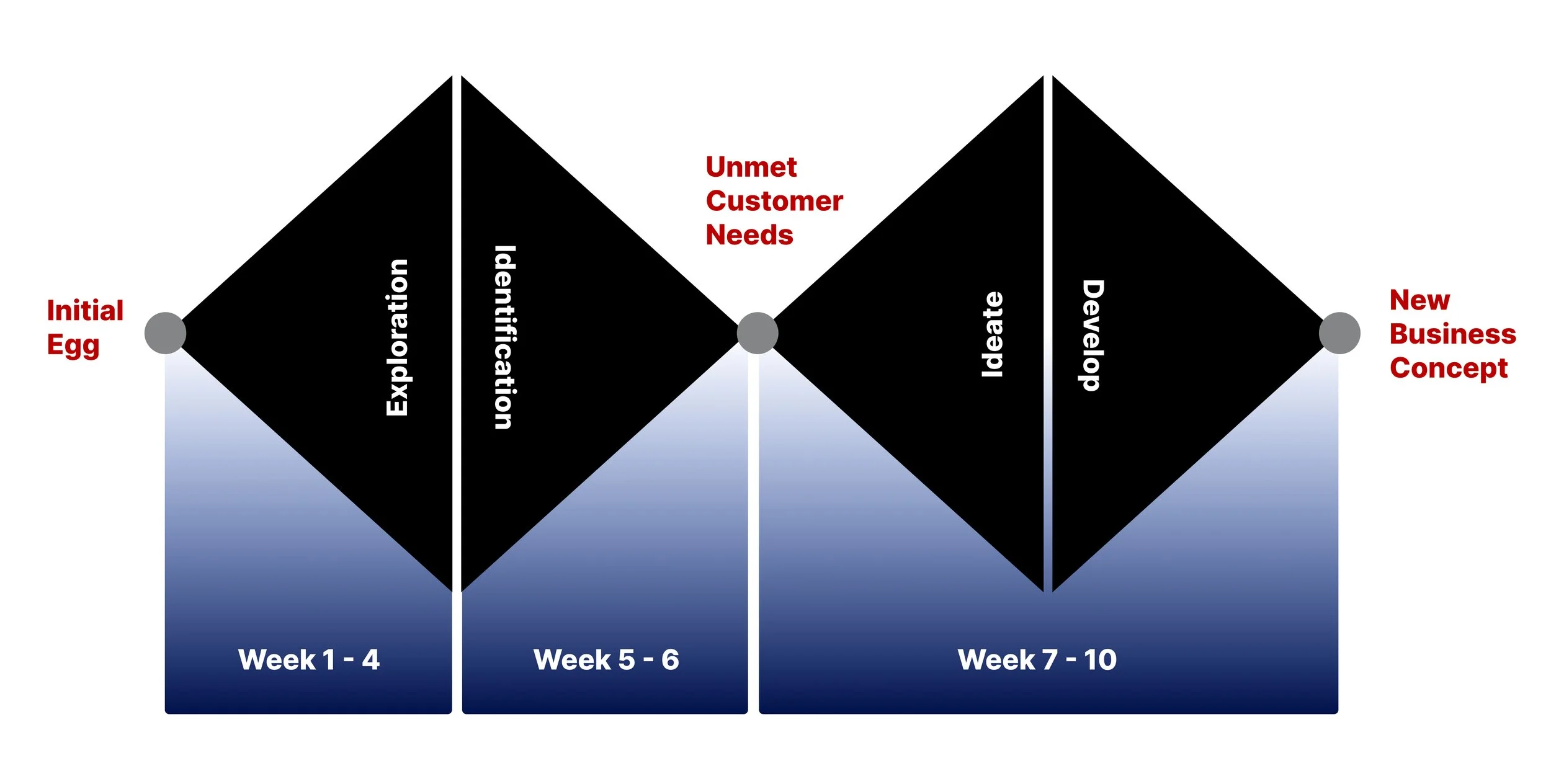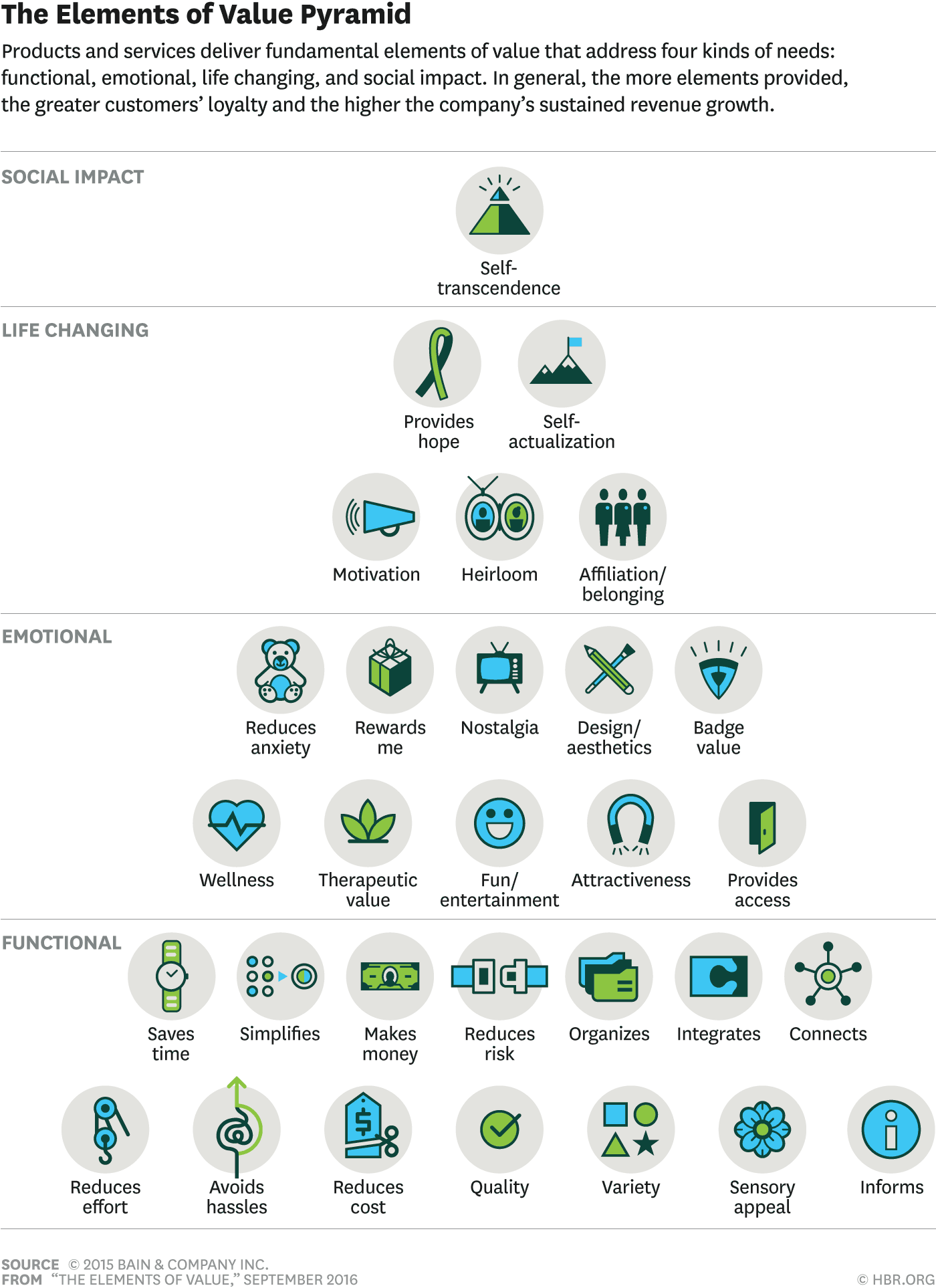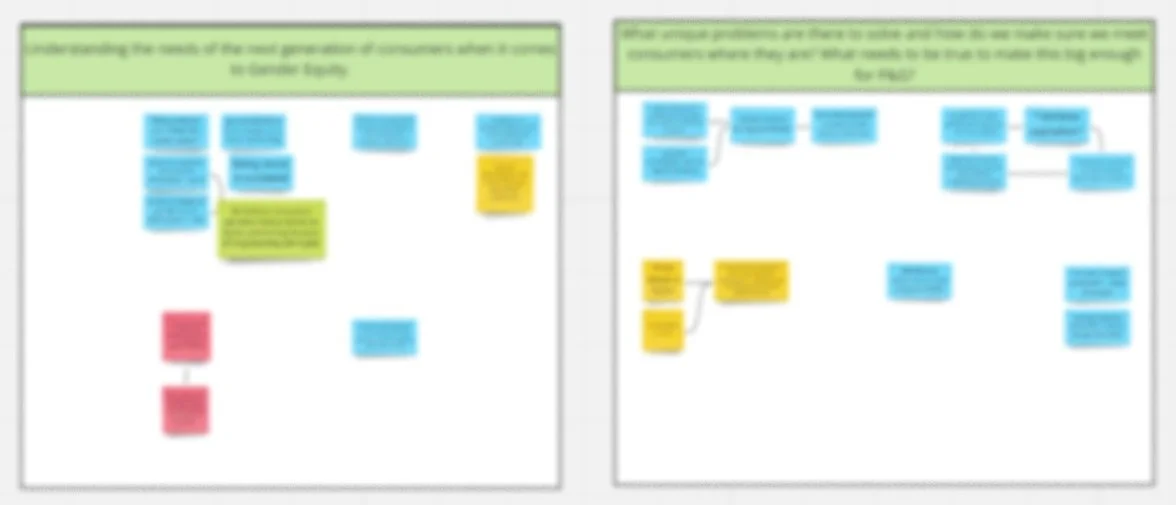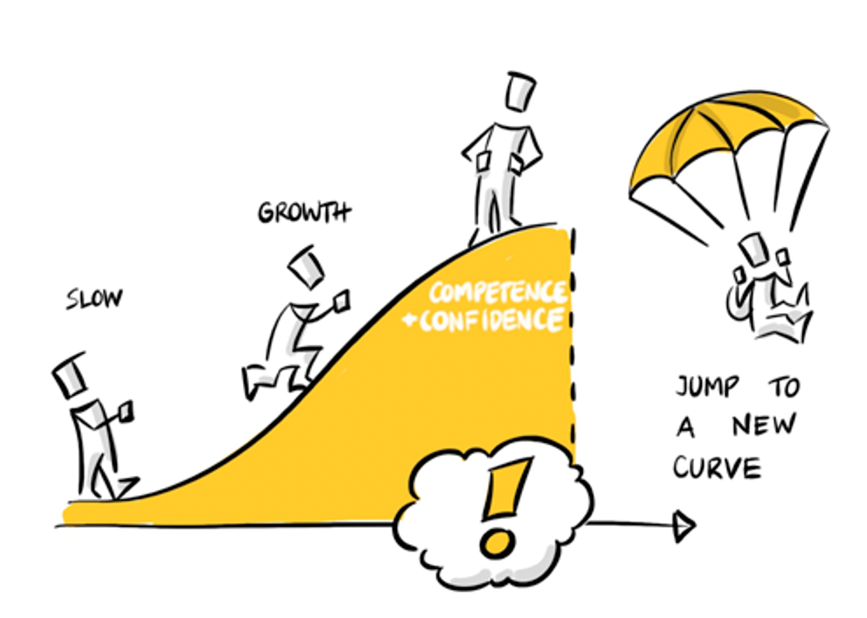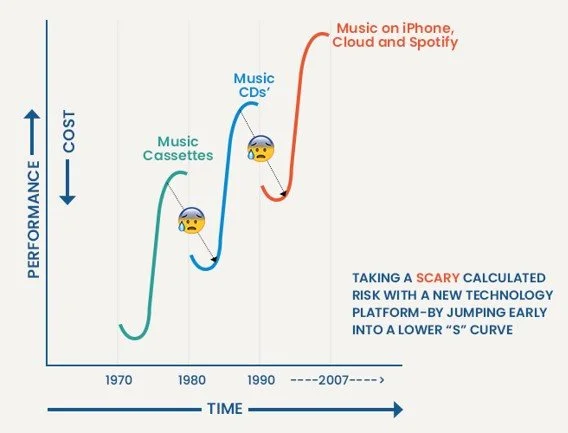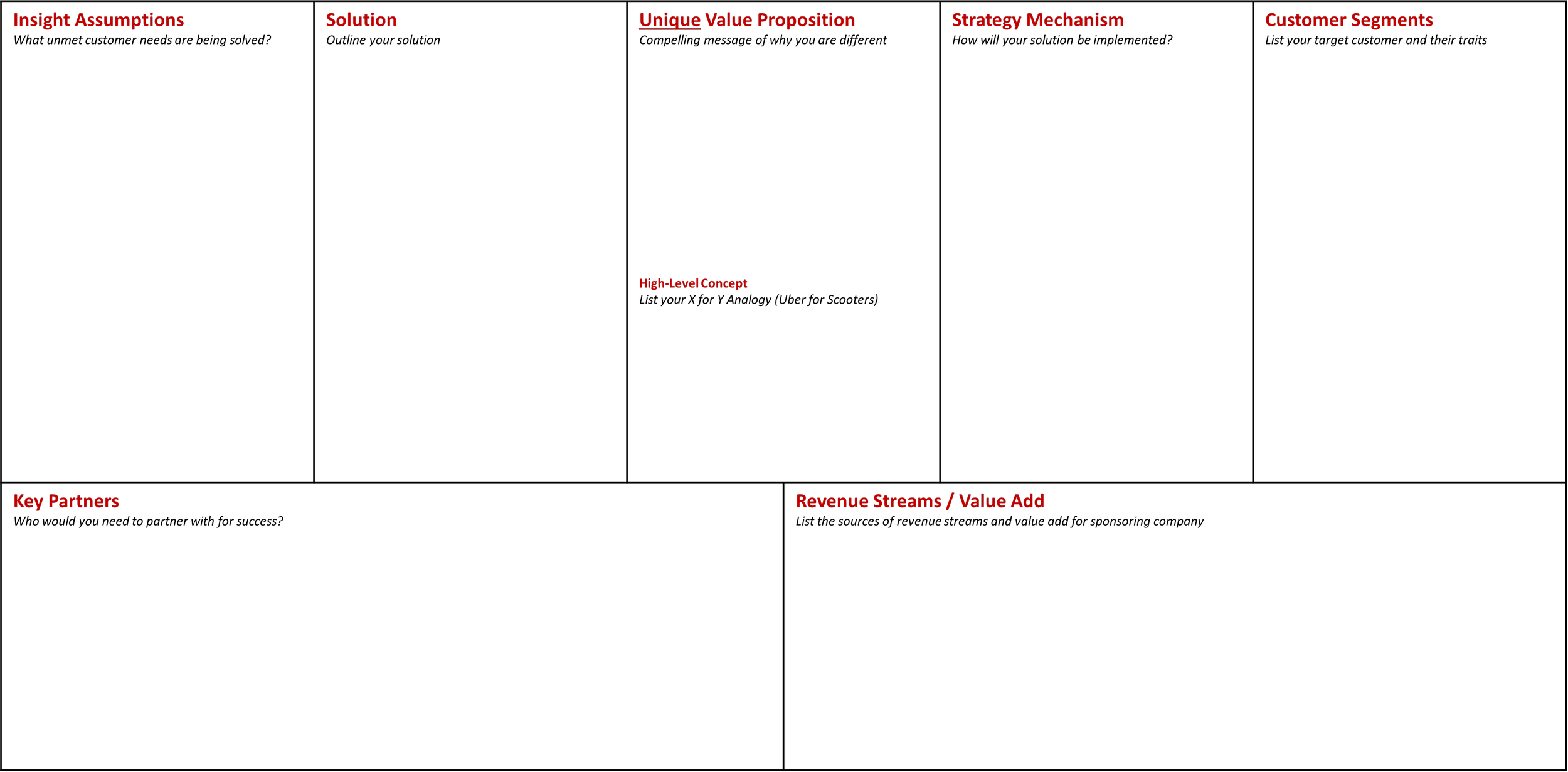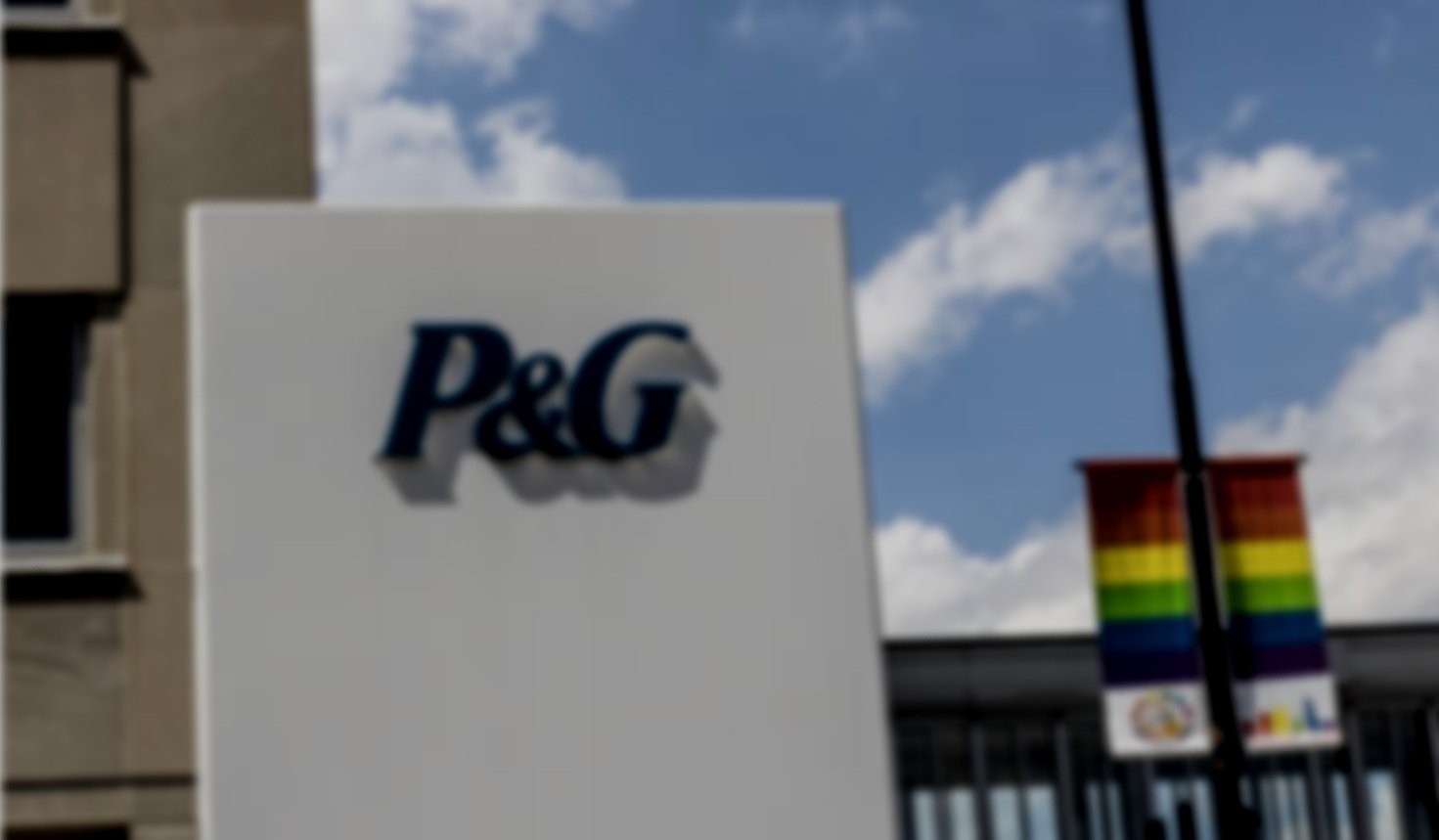
OnRamp Innovation Program
Where our creativity can take the business and our community to?
The goal of OnRamp is to uncover unmet customer needs about the world around us, build actionable insights, and propose data-driven solutions that make our sponsors think differently.
Due to the confidential disclosure agreement (CDA), I am not able to reveal specific details of the project I have worked on. However, I am willing to share the innovation process, my experiences, and what I have learned from this valuable internship with our sponsor, the lead, and my teammates on a surface level.
Although it’s not an HCI or UX-related project, most of the working and thinking processes are similar. I believe this experience has leveraged my lateral thinking and problem-solving skills, and also developed my entrepreneurial mindset.
-
W1 – Goals and Ideas
W2 – Interview Prep + Brain Dump
W3 – Outreach Week
W4 – Interview Week
W5 – Data Mining
W6 – Insights Review
W7 - Spring Break
W8 – Solutionstorm + MVP Creation
W9 – Business Modeling / Concept Dev
W10 – Deliverable Creation
-
Our sponsor provided us with 4 eggs. Each egg listed detailed research and requirements for topics that they are eager to further explore, including hypothesis, task, example, target customer, and value to enterprise. Each egg was then assigned to a team of 4 students based on our interests.
Along the way of extensive research, we hosted several review sessions with our sponsor to update the progress and validate value alignment. During the final week, each team presented their key insights and proposed visionary solutions.
-
• Collaborated with a team to vet early-stage innovative ideas for corporate sponsor
• Built unique customer-focused solutions using the fuzzy front end and lean start-up methodology
• Generated qualitative research for data insights using in-person customer validation interviews
• Pitched evidence-based concepts and solutions to senior leaders for consideration in the sponsor’s innovation pipeline
-
• Double-diamond Thinking Process
• Market Research & User Research
• Interview Techniques
• Identifying Insight Assumptions and Unmet Customer Needs
• Solution Ideation and Iteration
• Final Deliverable with Mockups
-
Take the Initiative
Be a proactive problem-solver and I will have the opportunity to acquire more support, resources, and critique to generate the right insights.
Become a Team Player
Effective Communication & Open to Critique
Collaborating with an interdisciplinary team promotes innovative work but also requires team members’ effective communication to express and criticize ideas clearly.
Be Confident to Speak out
In my team of 4, I am the only female & international student. I practiced to be more confident when conveying my ideas during the meetings.
Data Validation
The data from our research is more important than our solutions. Our solution will change moving forward, but the foundation of insights will not.
Ask Help as Innovation Work is Not Clear
We will most likely get lost or overwhelmed, but we have great resources in the program. We are doing ourselves a disservice by not asking for help. Onramp is a supportive cohort pushing ideas forward.
-
Thinking back through the entire process, I think it could be better if we can ask more questions with our sponsor. Knowing their needs and constraints is equivalently important to meeting unmet customer needs.
To Explore More
Meet The Team —
-

Christian Lampasso
PROGRAM COORDINATOR
-

Clay Scherer
FINANCE + MARKETING
-

Toby Williams
COMPUTER SCIENCE
-

Kenneth Trinh
FINANCE + REAL ESTATE
-

Claire Lu
FINANCE + ANALYTICS
OnRamp Process —
01 Exploration
Step #2 - Prepare for Data Gathering
• Asking questions – What do we not know? / What do we want to know?
• Identify target customers for outreach
• Build exploratory questionnaires
02 Identification
Step #3 - Interviewing
• Conduct 40+ interviews with the team
• Understand “what is going on here?”
• Uncover unique information
Step #4 - Data Mining
• Map out all information on Miro
• Identify trends and insights
• Create Unmet Customer Need to base solutions on
03 Ideate + Develop
Step #5 - Solution Ideation
• Lateral Generation of 100+ concepts
• How unique and out-of-the-box can I get?
• What will disrupt the status quo?
Step #6 - Business Modeling
• What components of each solution make sense?
• How do we create the most value for our sponsor?
• What product would customers actually use?
Step #1 - Immersion
• Select project + familiarize with Tasks
• Conduct an initial internet deep dive
• Discuss research with team to understand pathway forward
Corporate Innovation Pillars —
Performance Engines
- Companies are not innately built to innovate – Built to sustain the core business
- Make every activity repeatable + predictable
3 Horizons
- Incremental Improvement – Tweaks to the core business
- Adjacent Possibility – New asset + same customer // New customer + same asset
- Transformative – Concepts disruptive to the performance engine
OnRamp (Us)
- Identifying potential new business strategies
- Push the envelope + think differently
Our team’s Progress —
Review the Egg:
1. What do we think we know?
2. What should we test to see
3. What direction should we take?
4. What confuses us?
Conduct Personal Secondary Research:
1. Search the Web/Reddit/Tiktok
2. What are people saying?
3. What are interesting insights?
4. Save our sources
Teams of 4 students were formed based on our topic preferences
01 Brain Dump —
Hierarchy of Needs
Social
In what way do they want to be perceived by others while executing their jobs-to-be-done?
Emotional
How does our customer feel or want to feel while executing the functional job?
Functional
What underlying task does my customer want to achieve with my product or service?
Step 2: Jobs To Be Done = The Why
Customers often buy things because they find themselves with a problem they would like to solve.
With an understanding of the job for which customers find themselves hiring a product or service
Once I get clarity on why someone wants something, it makes it easier to create the right product.
Customer Discovery
01 Exploring interview Types
- What individuals will give us diverse information?
Different interview types will give us different sets of information
Interviewing multiple interview types will give us a more holistic view of the space
We must create different exploratory buckets to ask different questions
Business Model Innovation
Actionable Insights Needed to Move Forward:
Identification of an unmet need of a large group
Narrowing focus into a specific job-to-be-done that current solutions only include
Development of a new technology to leverage or using existing technologies in new markets
Defining a Value Proposition
Industry – a group of proven business models around a definitive customer need
Value Proposition – the value a business promises to deliver to their customer
Business Leaders continuously evolve to provide value to the present consumer
Step 1: Identification of Unmet Customer Needs
What do the customer want?
=> They want a problem solved
=> A need to be fulfilled.
Product-oriented:
“I need an iPod to listen to music.”
(Focusing on a product)
Job-oriented:
“When I go running, I want to motivate myself and set my pace with some music.”
(Focusing on an outcome)
A potential customer + Our product =
The job our customer hopes to get done
(What our customers really want)
03 Where do we find other interviewees?
Internet Groups - Users
Reddit (Subreddits)
Facebook (Groups)
LinkedIn
Discord
Twitter (Search Tweets)
Various Forums
Ohio State
Students
Teachers
Alumni (LinkedIn)
Article Authors
Reach Out with Email
QUORA
Researchers
Unique Databases
Related / Start-Up Companies
02 Where to find target customers?
Target Customer: Watercolor Painters
OSU Watercolor Class List
Michael’s Watercolor Aisle
r/watercolor
Target Customer: Recent Break-ups
Valentine’s Day Locations
Dating App
Article about “How to handle a breakup”
Target Customer: Vinyl Collectors
Vinyl Stores
eBay or Online Vinyl Marketplace
Vinyl Facebook Groups
Target Customer: Adventurous People
Backpacking Trip
College Clubs (not just OSU)
Rock Climbing Gym
Business Model Innovation
Customer Discovery
Our Team’s Progress —
Step 1: Brain Dump
1. Scheduled a secondary meeting
2. Discussed initial research with the Team
3. Developed 5 Interview Types
(Where will we find them? )
(What do we want to ask them?)
Step 2: Contact List
1. Created Contact List in Google Sheets Doc
2. Each member acquired 75-100 contacts
3. Brainstormed and divided customer lead routes
(Team Member #1 - Reddit/Discord/Twitter)
(Team Member #2 - Article Authors/Researchers)
Team’s Miro Research Collage was built
02 Questionnaire & Interviewing —
Open-ended Question
Long Answers
The best questions are those which elicit the longest answers
Do NOT ask questions that can be answered with one or two words unless it is necessary
“Tell me about” – an invitation for our interviewee to tell a story
Diving Deep
Trying to understand WHY someone answered the way they did
A deeper understanding comes from peeling back the layers of answers
Holistic Answer: For every question, I should attempt to dive deeper into smaller answers to get a more holistic answer.
Jobs-To-Be-Done: Have planned follow-up questions that are attempting to understand the Job-To-Be-Done (The Why)
“I listen to podcasts while I’m driving” – “What need do podcasts fulfill for you then?”
“What need does this fulfill?” - Example
01 What activities do you do in the car when you’re by yourself?
I pretty much only listen to music.
02 What need does music fulfill for you?
It helps me feel distracted
03 Why do you need to feel distracted?
It helps to pass the time and I feel less anxiety while I’m on autopilot
Sticking to the Script
Have a Flexible Interview
Be willing to make on-the-spot revisions to our protocol
The best pieces of information come from an undirected pathway – Always ask Why!
We have no idea what the interviewee is going to say
It’s Just A Conversation
Start with a light introduction and casual chit-chat
They agreed to the interview – Keep them talking while we are listening
If a question isn’t getting good answers in our questionnaire – Change it!
“The best interviews go off script to construct a holistic understanding.”
What are the functional, emotional, and social JTBD for these individuals?
Develop exploratory open-ended questions to allow customers to tell stories
Extra Helpful Information
Question Testing - How do we know if a good question is good or not?
Interview ourselves - Ask myself or teammates to answer the question as if an interview type
Make sure the question is framed for respondents to answer freely
Put me in the shoes of the interview type - Will they have the info I am looking for?
Tag Team Interviewing
Much easier to focus on the interview with two people
One asking questions while the other takes notes - Capture direct quotes
Note taker can listen and JTBD follow-up questions
Our Team’s Progress —
Step 1 : Questionnaire Build
1. Built separate questionnaires for interview types
2. Duplicated Template provided in Google Drive
(Demographic / Warm-up/ psychographic)
(Exploratory questions about concept space)
(What questions from our egg can be answered)
Step 2 : Outreach Week
1. Reached out to Interview Excel List
2. Stayed organized - who responds/who doesn’t
3. Scheduled Interviews for next 2.5 weeks
4. Developed outreach system with email templates
40+ Interviews with 15-30 min each
25+ Questions crafted for each group
03 Data Mining —
-
Given problem space to investigate from egg
-
General information gathered from interviews
-
Unique derived assumptions from data mining
-
An opportunity or problem that can be innovated on
Data Analysis Steps
02 - Data Learnings
Step #1: Data Organization
Take screenshots of questions and answers from Google Forms separated by Customer Type
Step #2: Data Learnings
Read through question answers and create post-its of our learnings from the data
Common Trends
Summary of Information
Interesting Facts
Specific Quotes
Highlight Outliers
03 - Insight Assumptions
Step #3: Answers to Tasks
COPY Data Learnings to begin an understanding to the questions from Tasks
Answers to Tasks
Locate Cluster Similarities
Interesting Conclusions
General Gathered Information
Step #4: Develop Insight Assumptions
Insight Assumptions are the strongest findings from our research
Starting Point for Solutions
Problems + Opportunities
Link Examples to Interviews
Assumptions not Facts
Can Focus on Negatives
01 - Tasks Setup
Example
01 Data Learnings:
Losing umbrellas is a worry
People forget to bring one if it’s raining
It’s not part of a normal routine
It’s hard to lug the umbrella around
Then we get…
02 Derived Insight Assumption:
We believe consumers don’t want to own an umbrella because they only want to use it when they need it.
Our research shows that other companies such as Bird & Lime have parallel services for renting when it comes to transportation.
Then we get…
03 Unmet Customer Need:
[Customer…(descriptive)] + [need (verb)] because [insight…(compelling)]
College students need a solution for quick and easy access to an umbrella because they do not wish to carry around an umbrella during their day
04 - Unmet Customer Needs
Step #5: Create Unmet Customer Needs
Where can we innovate?
Can Be Aggregate of Insights
Can Be A Single Insight
OK if a Solution Exists Already
Other Groups Will Build on This
In our Miro board, our tasks that were given to us from our egg are listed with extra additional space for ‘Other Insights’
Step #6: Research Support
Add Supporting Data + Secondary Research to Slides
Miro Analysis Process
Our Team’s Progress —
Data Mining + Insights Generation
1. Completed our final interviews
2. Completed our Data Mining Process
3. Each member generated 2 IA/UCNs that we wish to present on Insight Review Day
4. Communicated to the team on Miro about what insights we are investigating & critique
5. Used Google Drive template to finalize our Insights Review slide within the Deck
04 Insights Review —
Insights Review Day
Presentation of Insights Deck to Sponsor
Each member presented our IA/UCN
Discussed why we obtained these insights
Always refer to interviews and to our data
Goals of Insights Review
Update sponsor on research completed so far
Designate a Note Taker for P&G’s Discussion
Answer any questions we have for our sponsor
We are the experts of our project
They want to know what we’ve learned
It’s okay to not know something if we are prepared
Focus on the data and what we gathered
“Did your team research any information about…?” = “Our team did not gather info about that”
05 Solutionstorm —
Lateral Thinking
Break out of comfort zone of what I think is best and explore other possibilities to ensure better ideas are not missed or not explored.
Never judge ideas
Move away from fixed pattern recognition
Focus on significant change
Indirect approach using reasoning that is not immediately obvious
Looking at problem from sides rather than head-on
Seeks solution through untraditional methods
S-Curve of Innovation
McKinsey’s 3 Horizons of Growth
H1 (Incremental) – Continuous Improvement
Improving a single technology’s performance
Lower costs of operations and procedures
H2 (Adjacent) – Customer vs. Asset
Warp existing products into new usage
Moving products into adjacent markets
Capitalizing on a narrower unmet customer need
H3 (Disruptive) – Market Creating
New products are created under conditions of extreme uncertainty
Most promising ideas are those that are polarizing – Love it or Hate it
Ideas that cannibalize current products rarely come from inside a business
Innovation Work is Fuzzy
Do not need to know which Horizon a solution fits
This is just a model for us to start thinking differently
Use this framework to think for the near/far future
Be Creative & Think Big!
Build a vision for how our unmet customer need can be solved without legacy
Feasibility is not our job at the current moment
How can our sponsoring company integrate our insights to build a new market?
Vertical vs. Lateral
“Lateral Generation is not about creating a great idea. It’s creating a lot different ideas.”
Lateral Thinking Skills
Alternatives
What could be a different component of our problem that could be attacked to generate a new result?
Challenge
Identify and break free from traditional methods by proposing unorthodox and less efficient methods
Focus
Instead of trying for the best solution, direct our focus to generate concepts from fresh unexplored areas
Random Entry
Utilize random input to open new lines of thinking. Find relations with seemly unrelated things to provide new value
innovationmanagement.se
What happens if we identify:
- A new technology?
- A different unmet customer need?
- A new type of customer?
Solutionstorm Workshop
1hr Workshop with entire OnRamp Cohort
All teams will have an Ideation Station on a Miro Board
Every 20m randomized breakout groups will ideate inside each section
Why vs. How
Why questions were used to gather deep insights in our investigative wandering to unwind customers’ true needs.
How questions are used to provoke ideation and the consideration of different solutions to revolve an insight.
Our Team’s Progress —
Step 1: Build Solutionstorm Station
1. Each member created our own solutionstorm station inside Miro Board:
(Background / IA + UCN / How Statements / Catalyst Questions)
2. 5 preliminary ideas (per team member) inside the station
3. Develop a “Growth Mindset Environment” for others
Step 3: Solutions Mapping
1. Copy & Paste “Ideation Station” back to Miro Board
2. Group Post-its together with like-minded thoughts
3. Begin to develop solutions for MVPs
Step 2: Three 15-minute sessions with other teams
1. Station Member acted as facilitator
2. Briefly discussed project - less than a minute
3. Ask questions to group members as they work
(Clarify / Dig Deeper / Ideate / Build on Thoughts)
4. Answer any questions group members might have
Create as much content as possible
· Startups and similar concepts
· Potential partners & acquisitions
· Add pics and prototypes from Google
06 Concept Development —
Build Concept Canvas
Strategy Mechanism
“Be creative in our approach to our business implementation”
Borrow / Build / Buy
Not all solutions need to be built from scratch
P&G as a company can make strategic moves to partner with others
Acquire existing companies to obtain their final goal
Difference in Strategy
P&G spending 3 years and $500M to develop a meditation app from scratch?
P&G purchasing Headspace for 1.5B with 70 million current users?
Value Add
What is your compelling argument?
Why should your sponsor get your ideas into their innovation pipeline?
Be explicit about what you’re trying to achieve
How can we add value to our sponsoring company?
Revenue Generators
Standalone product generates money through business model
Customer Generators
Attracting a new type of customer to sponsor
Insight Generators
Understand new & emerging customer needs
Visualization
Goals of Visualization
Focus on understanding the customer journey through our idea
Help to define what our proposal could look like
What aspects of the idea might be difficult or impossible to implement
Visualization Delivery
Prefer concept visualization is delivered through a prototype – Not always possible
Reference pictures can be for building a visualization
Take time to research the correct photos – This will not be our first google search
Branding
Naming – Namelix
Type in keywords related to your concept
Search through the list of generated
Change keywords as you go
Make sure to scroll down far enough!
Logo – Looka
Sign up for a free account
Walkthrough initial logo creator prompts
Edit your logo using the edit functions
Do not get sucked into making it perfect
Create MVP Statement
Minimal Value Proposition:
<Concept Name> would like to address the <UCN/IA> for <Customer> resulting in <Objective or Goal> by providing <Solution> via <Strategy Mechanism (Build/Borrow/Buy) + (App/Service/Product)>
Uber Example:
<Uber> would like to address the <current over-priced taxi space> for <individuals between the age of 18-45> resulting in <quick and easy transportation> by providing <a service where anyone with a car can become a taxi driver> via <building a standalone ride-hailing app>.
Our Team’s Progress —
02 Concept Canvas
1. Used feedback from the internal meeting to develop final concepts
2. Build out Concept Canvas on Miro
3. Focused on creating a compelling argument of innovation for sponsor
Internal OnRamp MVP Presentations were hosted
03 Visualization + Branding
1. Used any technique available to create a prototype / visualization (Reference pics if not work)
2. Went to Namelix + Looka to finalize our concept
01 Internal OnRamp MVP Presentations
2 Breakout Room Discussion on concepts and builds for Strategy Execution
Each Team Member developed a Slide for their Concept
· Conduct Research on our identified MVP to develop it into a viable concept
· MVP Statement / Core Features / Key Assumptions / Competitive Analysis / Catalyst question
· This is a starting point for a concept so it’s okay for it to be messy - The cohort will help!
07 Deliverable Creation —
Deck Structure
02 Research Summary
i. Interview Tactics
How many people did we interview?
Where did we find them?
What are some of the best questions asked?
ii. Insight Assumptions
Teach our audience what we learned
Provide concise valuable information
Do we have secondary data?
iii. Unmet Customer Needs
Focus on IA + UCN that relate to our solutions
Do NOT pack a ton of information on one side
Convince audience this is a problem to fix
03 Proposed Solutions
i. What is our Solution?
No MVP Statements
Use this slide to WOW the audience
What IA + UCN was this built from?
ii. How Does it Work? – Visualization
What are the core features?
What would this look like if it existed?
Walk the audience through a journey
iii. Why Is It Important? – Strategy / Value Add
Why should the company invest in this?
How will this make money?
What are the costs associated with execution?
Are there intangible value adds?
Are there major risks involved?
Presentation Details
Building the Deck
Refrain from changing template structure
Do not mash 10 points on one slide – Separate them out
Presentations are 15 – 20 minutes
Deck Content
Assume the audience has never heard of our project
Teach what we have learned from research
Always refer to data of WHY we have our final concept
01 Team Intro
02 Research Summary
03 Proposed Solutions
04 Appendix
Context & Overview Slides Required
Individual Concept Refinement
Worked on our individual slides - formatting + talking points
Went to Zoom and recorded a draft mock presentation of our own section (5min)
Submitted our recordings in team’s Basecamp by Sunday
Our coordinator reviewed all content and uploaded his notes and changes
Workshop - Draft Creation & Task Assignment
Worked with our team to organize the slide deck
Each member selected which section we wished to present
Followed the slide creation system from the workshop’s PPTX
Attached screenshots of Miro Boards / Concept Canvas / Insights Review as Appendix
“The above is the accumulation of all the work we have done in the past 9 weeks!”
Final Presentation
Dress Code: Smart Casual
20 Min Presentation + 20 Min Q&A

